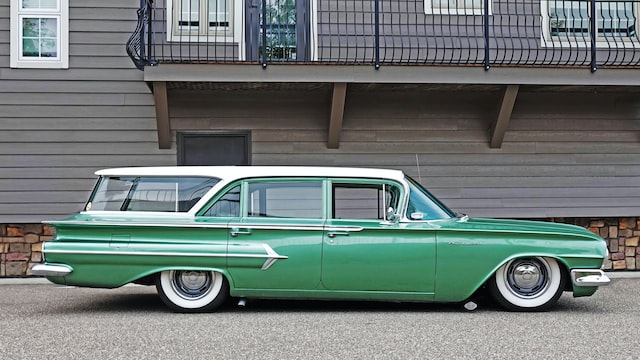Contents
- 1 Introduction
- 2 The term ‘station wagon’ is a bit of a misnomer.
- 3 Certain vehicles that are considered station wagons are not actually from the 1900s and 1910s, when the word was popularized.
- 4 A station wagon is basically just a large, practical car with an upright design.
- 5 It’s hard to say what defines a station wagon because there are so many variations on the basic idea.
- 6 Ford had its own version of a station wagon in 1936, but this didn’t change much.
- 7 Station wagons have taken many forms over time because they’ve always been flexible designs.
- 8 There are many different types of cars that fall under the category of station wagon, so it’s hard to pin down exactly what makes one fall into that category
- 9 Conclusion
Introduction
I love station wagons. They’re practical and spacious, plus they have a unique, classic design. I also happen to know that there are many different types of station wagons out there! Some people think that station wagons were popular in the early 20th century, but this isn’t true. The term ‘station wagon’ didn’t come into use until the late 1950s when Ford released its own version of this car type.
The term ‘station wagon’ is a bit of a misnomer.
The term ‘station wagon’ is a bit of a misnomer. The word ‘wagon’ comes from the Latin word ‘vagum’, which means ‘to wander’. In its earliest use, it referred to any vehicle that could be pulled by horses or oxen–including carts and carriages of all kinds. It wasn’t until around 1900 that station wagons began appearing in America as horse-drawn carriages used by wealthy families who wanted their own private transportation on the road but didn’t want to drive themselves (or risk getting lost).
Certain vehicles that are considered station wagons are not actually from the 1900s and 1910s, when the word was popularized.
You may be surprised to learn that the term “station wagon” was popularized in the 1900s and 1910s. This is strange, because most people don’t think of vehicles like these as station wagons at all. However, they’re actually just large, practical cars with an upright design–so they can fit things like luggage or groceries more easily than other cars.
The word “wagon” comes from the fact that this type of vehicle originally had a box on its back (like a covered wagon), which was used for transporting goods and supplies across long distances by horseback or oxen before automobiles were invented. The term ‘station’ refers to how these vehicles were used: people would stop at certain places along their journey so their horses could rest for a bit before continuing on their way again; these places became known as “stations.”
A station wagon is basically just a large, practical car with an upright design.
A station wagon is a car with an upright design. It can be any make and model, but generally they’re large, practical family cars. The term “station wagon” comes from the fact that these cars were originally designed as passenger vehicles for use at train stations or other places where cargo was unloaded from trains.
Station wagons have evolved over time to include features like fold-down seats for extra storage space and increased headroom for taller passengers (for example). They’re also called “estate cars” in some countries–this name refers to estates (or manors) where people lived in England during medieval times; the word “estate” has come to mean any large property including farms and homes rather than just mansions since then.
It’s hard to say what defines a station wagon because there are so many variations on the basic idea.
It’s hard to say what defines a station wagon because there are so many variations on the basic idea. Some people call them estates and others call them hatchbacks, but they’re all basically just large cars with an upright design that makes them practical and versatile vehicles. They’re popular in Europe and North America, especially for families who need more space than a sedan can provide without compromising their style preferences.
Ford had its own version of a station wagon in 1936, but this didn’t change much.
Ford had its own version of a station wagon in 1936, but this didn’t change much. It was still a three-box design with four doors and was a variant of the Model A. This time, however, there was no rear seat and it had no windows in back. The boxy design wasn’t very popular at all; Ford stopped making wagons after 1940 because they weren’t selling very well (though some could be found used).
Station wagons have taken many forms over time because they’ve always been flexible designs.
The term “station wagon” can refer to any type of vehicle that has a cargo area at the rear and seating for five or more passengers. In other words, it’s not just about the size or shape of your car–it’s also about how many doors it has and what kind of features it has inside (like a roof rack).
Station wagons have taken many forms over time because they’ve always been flexible designs. They can be any size, shape or style: from small hatchbacks with two doors all the way up to luxury sedans with four doors. Some station wagons have no roof rack at all; others have racks big enough for skis and surfboards! Station wagons may also have limited-slip differentials instead of locking axles so they can handle winter roads better than most other vehicles on the road today.”
There are many different types of cars that fall under the category of station wagon, so it’s hard to pin down exactly what makes one fall into that category
There are many different types of cars that fall under the category of station wagon, so it’s hard to pin down exactly what makes one fall into that category.
There are three main factors that define a station wagon:
- It has more than two rows of seats
- The trunk is accessible from inside the vehicle (not just outside)
- It’s marketed as such by its manufacturer
Conclusion
The term ‘station wagon’ is a bit of a misnomer. It’s hard to say what defines a station wagon because there are so many variations on the basic idea.

